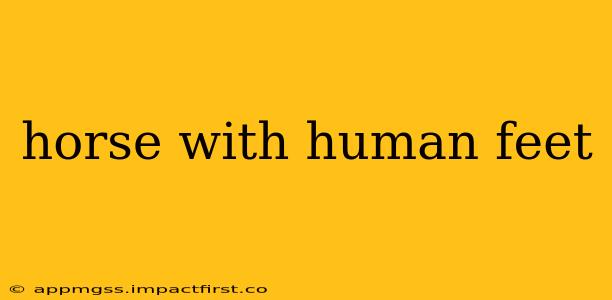The captivating image of a horse with human feet sparks immediate curiosity. Is it a mythical creature, a medical anomaly, or simply a product of artistic imagination? The answer, as we'll explore, is multifaceted, encompassing elements of folklore, potential genetic mutations, and the enduring power of artistic interpretation.
What Causes a Horse to Have Human-Like Feet?
This question lies at the heart of the matter. While a horse with fully formed, functioning human feet is biologically impossible, the concept arises from a few different sources.
First, artistic license plays a significant role. Throughout history, artists have depicted creatures that blend characteristics from different species, often for symbolic or mythological reasons. Centaurs, for example, combine the upper body of a human with the lower body of a horse. These representations aren't meant to be scientifically accurate but rather serve a narrative or artistic purpose.
Second, we can consider the possibility of extreme genetic anomalies. While highly improbable, severe developmental mutations could potentially lead to malformations in a horse's limbs. These might superficially resemble human feet, though they would likely be non-functional and pose significant challenges for the animal's survival. However, documented cases of such extreme anomalies are extremely rare, if they exist at all. Veterinary professionals haven't reported cases supporting this possibility.
Finally, the term "human feet" might be used loosely. A horse might have a leg deformity that, from a particular angle or in a particular stage of development, resembles a human foot, but the underlying anatomical structure remains equine.
Are There Any Real-Life Examples of Horses with Human-Like Feet?
No scientifically verifiable examples exist of horses born with fully formed human feet. Any images or claims suggesting otherwise should be treated with skepticism. It's crucial to distinguish between artistic representations, misinterpretations of unusual deformities, and outright fabrications.
What Are Some Famous Artistic Depictions of Horses with Human Feet?
The centaur, a staple of Greek mythology, is perhaps the most famous depiction of a creature combining human and equine features. Many artistic interpretations showcase a creature with a horse's body and human torso and head, implying the presence of human-like feet. This mythological being serves as a powerful representation of the human-animal duality and the integration of human reason with animal strength. But it's vital to remember that the centaur is a mythological creation, not a real creature. Other artistic works may use the concept for symbolic or surreal purposes, not aiming for literal biological accuracy.
Is It Possible for a Horse to Have Human-Like Feet Genetically?
Genetically, the development of a horse's limbs is entirely different from that of a human's. The complex interplay of genes and developmental pathways that shape a human foot is not replicated in equines. While genetic mutations can cause deformities, the complete transformation of a horse's limb into a functional human-like foot is biologically impossible within our current understanding of genetics.
Could Genetic Engineering Create a Horse with Human Feet?
While genetic engineering is advancing rapidly, the creation of a horse with human feet remains far beyond current capabilities. The complexity of limb development and the significant genetic differences between horses and humans make such a feat incredibly challenging, if not impossible, with our current technological understanding. Ethical considerations would also present significant hurdles to such an endeavor.
In conclusion, the concept of a horse with human feet is largely confined to the realms of mythology, artistic expression, and possible misinterpretations of severe limb deformities. While genetic anomalies can certainly occur in horses, the complete transformation of their limbs to resemble human feet is biologically implausible. The enduring fascination with this image highlights our ongoing fascination with hybrid creatures and our exploration of the boundaries between human and animal forms.
